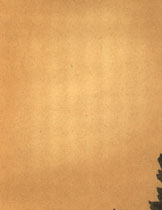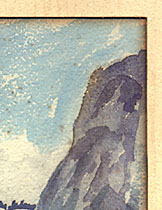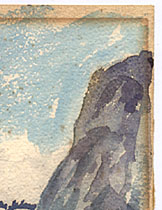|
|
Picture Frame Check-Up
By Andrew T. Lenz, Jr.
How do you know if your framed picture needs to be reframed? The case of the disappearing artwork. Your precious family heirloom photograph of your great-grandfather may be dissolving before your very eyes. If you care about a piece of art that was framed a while ago, or you are just concerned about the quality of the materials used, here's some things to look for:
- Check the mat. If the mat has a tan or off-white core bevel showing that is a different color than the surface, it most likely was matted using a non-conservation "regular" matboard. There are some conservation grade boards manufactured with an off-white/cream core with a colored surface, but these are uncommon and if your picture was framed prior to about 1990 and the mat has a creamy core and a different color surface, the board is most likely damaging your artwork.
The good news if the board appears to be a "regular" matboard, and your picture was framed after 1983, the board was buffered to help neutralize some of the acids inherent in the board, so it's causing less damage than it would otherwise. It's still in the art's best interest that you replace such a mat, however.
If the mat is the exact same color through and through, it most likely was matted using a conservation-grade museum board and that's a good thing. If the core of the board is a bright white, you are probably in good shape also. I say "probably" because there are boards manufactured now that sport a bleached core, giving them what traditionally has been the appearance of a conservation grade board, but are not.
- Check the art. If the art has a dark fringe around the bevel area of the mat, the mat is in serious need of replacement.
If the art has mottled darker areas or evenly spaced darker lines, your backing board is causing acid-burn to your artwork. The tan lines are from an acidic corrugated cardboard backing board. The worst damage I have ever seen was to an old oriental piece of art that had been backed with two slats of wood—extremely acidic! Second place would go to one backed with cardboard, followed by another backed with masonite (at least the one backed with masonite had an consistent acid-burn, though the damage was done in a relatively short period, less than 10 years).
Also look for fading. This may be more difficult to ascertain, but if you do notice color shifts, replacing standard glass with the UV-filtering variety will help prevent additional fading.
- Check the frame. Look any split corners of the frame or any cracks, check the hanging system on the back for any unraveling of the wire or fraying, or the wood splitting around any screws/screweyes.
- Check the glazing. Look any cracks or chips. Aside from obvious aesthetic concerns about a cracked piece of glass, once a piece breaks it can easily puncture or scrape your artwork.
- Check the framing "package." Look for insects, cocoons, warpage of any materials, make sure any back cover paper is intact.
- The Invisible. If you see any of the signs of damage or just want to have a professional take a gander (there can be things lurking inside that you can't see until you take it apart), gather up your picture and bring it by, we'll be happy to take a look at it for you at no charge.
|
|

Old print. Sample of acid damage on artwork as a result of long term contact with corrugated cardboard.

Old watercolor matted. Note the brown spots in the sky, known as "foxing."

Old watercolor with mat removed. Note the "burn" located both in the area which was under the mat and more substantially out past the bevel location. |




